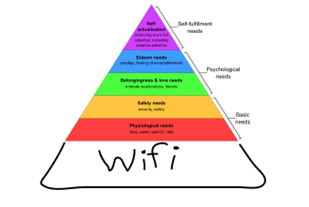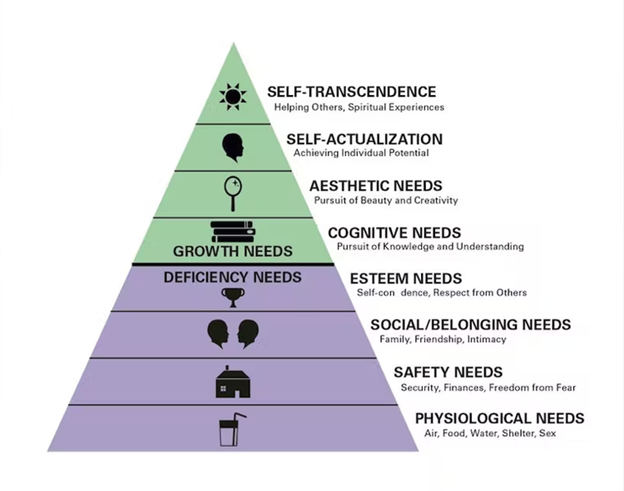By Andrea Hunsaker
“We can experience a union with something larger than ourselves and in that union find our greatest peace.
”
If I could look into the black box of my head, I wonder what percentage of my thoughts are about me. “My hands are cold. I can’t think of anything good to write. Just write my thoughts. I have no thoughts. The thought train has left the station. Ooh that’s good, they’ll think I’m funny. It’s not that funny. Is there any fudge left?” Granted, it is necessary to think about yourself for survival reasons. The heart pumps blood to keep you alive, the brain pumps thoughts to keep you alive. (And to the brain, social situations are survival situations since separation from the tribe was a death sentence back in the day.) It’s exhausting - All these thoughts looking out for threats trying to protect ourselves. And at the base of it is some form of the question, “Am I good enough?” The self can be a major source of suffering.
You may recall the hierarchy of needs you learned about in Psychology class. It depicts Abraham Maslow's theory of motivation—the things a human needs to live their best life. The picture in your book might have looked like this, with self-actualization (being all you can be) at the top (and probably a previous student’s contribution at the base - 100% accurate in my case).
But toward the end of his life, Maslow expanded his theory. He recognized the peak of human experience was more than achieving a person’s individual potential. Being our best self isn’t just about our self. He recognized through his research that people could, and do, rise above themselves and connect to something greater, and that humans need this connection to the whole in order to be whole. His revised theory looks like this with self-transcendence at the peak of human potential:
Self-transcendence is a merging between the self and the world around you; it is expanding the boundaries of yourself to include something greater (a cause, nature, humanity, or the universe). Let me give you a few examples of increasingly transcendent experiences:
An experience of love, connection:
I was out jogging along a dirt road when out of the corner of my eye I saw 3 little goats running toward me. I stopped and let them investigate my knees. I was honored that these beautiful creatures instantly trusted me and I felt a connection and a concern for their welfare. Their needs became mine. I didn’t want them to get lost or hit in the road, so I led them back to their nearby farm, rang the doorbell and chatted with the thankful owner as she returned them to their enclosure. For those minutes all the usual insecurities about myself were gone, all was right in the world. I had even forgotten about the triangular patch I wore between my eyes that day to keep me from squinting in the sun and deepening my frown lines, and when I remembered mid-conversation with the goat mom, it didn’t even phase me, and I didn’t even lie about my name or plan a new running route to never see her again. Now, I feel a warmth in my chest every time I run by my little goat buddies.
An experience of peace and awe:
A fresh six inches of snow had fallen overnight, and after shoveling the driveway, I went out and laid down in a clearing in our Michigan forested property. I remember a great silence and an overwhelming sense of peace and warmth as I looked at the sky and the sparkling snow covered landscape. I felt like I was a part of it all—the unspeakable beauty, mystery and majesty. The magnificent snow covered world that included me was just right as it was. It is hard to describe, but I have never forgotten that feeling of awe and belonging.
Jared’s peak transcendent experience:
I was on one of my first astrophotography adventures, alone at about 2:00 am, overlooking Delicate Arch in Arches National Park (Utah). I was waiting for the moon to set so I could have the darkest sky possible to photograph the Milky Way. I sat there for at least a couple hours in the deep quiet, admiring the unique sandstone landscape and the brilliant expanse of stars. I still don’t know what made this happen, but as I continued to take in the scene, I started to feel myself being absorbed into it. Instead of a sense of looking out from a place inside my head, it was as if I had no head, no body. There wasn’t a “me” anymore. I was the whole landscape, the whole sky. There was a sense of extraordinary calm and satisfaction. Everything was perfect, and nothing could change that, not even death. -Jared Warren
Transcendent experiences (often called peak experiences) are surprisingly common. About ⅓ of the U.S. population reports they have had an experience where they have ‘felt at one with all things’ (Yaden, et al. 2017). The religious and non-religious alike, throughout time, across culture, age, gender, and socioeconomic status all report having peak experiences (Maslow, 1964). Though these unusual moments of awe, joy, serenity and wonder come as gifts, unplanned and uncontrolled, we can cultivate a way of being to be more receptive to them. Flow states, gratitude, savoring, mindfulness and meditation, spending time in nature, spiritual practices like prayer and pondering, intimate moments with family or friends, and aesthetic or artistic appreciation all foster states of transcendence where we can rise above the usual worries about the self and feel a part of something more. It turns out that the best life is when me becomes us.
If the subject of ‘getting over yourself’ interests you, explore our new module on Transcendence. There you’ll learn more about what it is, why it’s worth pursuing, and find ideas to cultivate and allow it to enrich your life.
“At the deepest level, there is no giver, no gift, and no recipient…only the universe rearranging itself.”
References
Maslow, A. (1964). Religions, values, and peak-experiences. Columbus: Ohio State University Press.
Yaden, D. B., Haidt, J., Hood, R. W., Jr., Vago, D. R., & Newberg, A. B. (2017). The varieties of self-transcendent experience. Review of General Psychology, 21(2), 143–160. https://doi.org/10.1037/gpr000010
1. Image retrieved from: https://en.wikipedia.org/wiki/Maslow%27s_hierarchy_of_needs
2. Image retrieved from: https://www.iands.design/architecture/article/10168474/look-to-maslows-hierarchy-to-see-design-and-architecture-impacts






